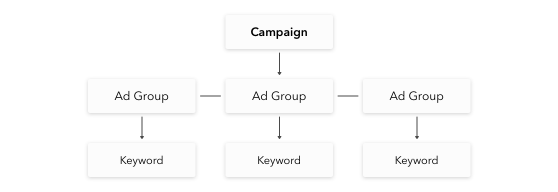This is by far my favorite way to structure a new AdWords account or restructure an old one. You can optimally target every single keyword with its own ad, making sure that your message is appealing every time. It helped me stop wasting money on ads that simply weren’t converting or weren’t relevant. Neil Patel, top digital marketer, on SKAGs
What started a few years ago as something of an AdWords hack to increase campaign performance, has now become a standard approach used by PPC marketers. Even now, Single Keyword Ad Groups (SKAGs) continue to be relevant for those seeking high-performing and well-organized campaigns.
This article is a plain-language overview of what Single Keyword Ad Groups are and why they matter.
Put simply, SKAGs are an account structure where campaigns are built with only one keyword in each ad group.
This is different to the way accounts are structured in Google Ads. On the Account level, you control the billing, user access, linked accounts and other settings. Within the account are campaigns, and the account can have many campaigns.

One step lower is the Campaign level. Here the daily budget, locations, devices, bid adjustments, etc. are selected. The campaigns house the ad groups, and there can be many ad groups in a campaign. At this level it is a good idea to create many campaigns to test different strategies, like brand, non-brand, and competitor keyword search campaigns.

The Ad Group level is where the keywords and text ads are located. Ad groups are a logical collection of related keywords and ad texts that are displayed when the keywords are triggered.

Every time a search is conducted in Google, the user enters a search term. Google matches that search term to keywords in an ad group, and displays a relevant ad. There can be up to 20k ad groups in an account, and each ad group can have up to 10k keywords and 50 text ads. These limits can become restricting when testing all possible combinations of keywords is a necessity.
The logical question that follows is: What is the best way to structure Google Ads accounts?
On the campaign level, the answer is as many as you need to test different strategies relevant to the business. But the amount of ad groups depends on the keywords.
In PPC, a healthy account structure means a tight connection between the ad groups and the keywords. A tight connection is when the search term, the triggered keyword and the triggered ad text are all very closely related.

Google suggests users put 10-20 keywords per ad group, which as it turns out, isn't good advice. With 10-20 keywords per ad group, it isn't possible to have this tight connection, and many other key opportunities are missed. Google suggests this just to help users get started quickly and easily. But this is an inefficient approach. And when users are inefficient, Google makes more money.
Enter Single Keyword Ad Groups (SKAGs). As the name suggests, SKAGs include only one keyword per ad group. Although this approach takes more time to set up, there are several benefits. Here are the top 3 reasons to start using SKAGs.
1. SKAGs increase your Quality Score. The Quality Score is one of the best predictors of success in a Google Ads campaign. Check out the research WordStream did on how quality scores influence costs. According to Google's Chief Economist, the cost per click is calculated using a formula which divides the Ad Rank of the ad below yours with your Quality Score. A top quality score lowers costs by up to 50%, while a poor quality score raises costs up to 400%. The best way to increase the quality score of an ad is with SKAGs. Why? Because when there is one keyword per ad group, Google understands there is high relevancy. As a result, it awards a high quality score.
2. SKAGs increase Click-Through-Rates (CTRs) which result in an improved quality score and ad position. CTRs are (total clicks on ad) / (total impressions). With SKAGS, the keyword perfectly matches the search term and the ad text, and therefore it gets clicked more often in relation to impressions. The ad position refers to where the ad is displayed on the search engine results page (or SERP). The top positions are the most valuable. With a higher CTR and QS from SKAGs, ads will increase or maintain their ad position when displayed.
3. SKAGs ultimately create reduced conversion costs. When ads cost less because of an increased quality score, they get clicked more due to increased CTRs and end up in a higher position on the SERP. The result is a reduced cost per click. And when the cost per click is down, so is the cost per conversion.
Other noteworthy benefits of SKAGs include:
-A clean account structure that is easy to update, maintain and optimize
-An easy way to switch off any underperforming ads and keywords
-Increased reporting accuracy
-Easier troubleshooting
Of course SKAGs aren't perfect. There are a few drawbacks to keep in mind.
The main problem is time. It takes a lot of effort to set SKAGs up because the structure is more granular. You also have to keep a closer look at the Search Terms report and apply negative keywords on the ad group level. This is also time consuming.
But for those that put in the work, the benefits greatly outweigh the costs.
Whereas the Google approach is to create ad groups with many keywords, the SKAGs method involves having every ad group with exactly one keyword in it. The structure will look like this:

Going one level down, the ad groups will have one keyword in many match types. The traditional SKAGs approach is to include three match types: [exact], "phrasal" and +broad +match +modifier.

The amount of ads recommended per ad group varies depending on the budget and the amount of impressions each ad is getting. But in general there should be at least three ads per ad group. Up to six ads per ad group is acceptable, if the ads are getting up to a lot of impressions (1k per week per ad). But this is a guideline more than a hard and fast rule.

Ultimately, SKAGs provide you with a healthy, granular account setup that easily improves campaign performance. While the extra effort at the start can seem intimidating, the rewards PPC marketers can expect to receive down the road make the added work worthwhile.
SKAGs will help you boost your Quality Score, increase your Click-Through-Rates and reduce conversion costs. It is far more effective than the traditional approach recommended by Google to create ad groups with several keywords.
But don't just take our word for it. Try them out and see for yourself.
If you have any questions, feel free to reach out! Chat with us
BACK TO What is Aori?